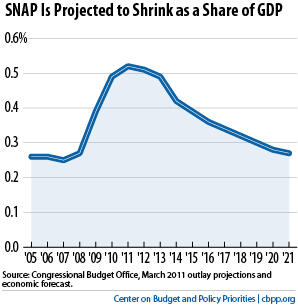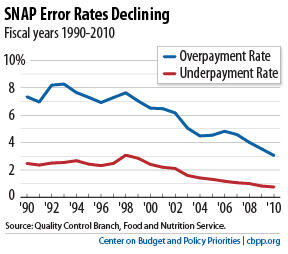James Bovard’s op-ed in The Wall Street Journal today claims that the nation’s most important anti-hunger program, SNAP (formerly known as food stamps), is beset by out-of-control growth and widespread waste and fraud. Both charges are demonstrably false.
Food stamp enrollment has grown considerably in recent years, but as we’ve explained, that growth is temporary and reflects the battered economic circumstances of tens of millions of Americans due to the severe recession.
As the first graph (based on Congressional Budget Office data) shows, SNAP did exactly what it’s supposed to do when the recession hit: respond quickly to help more low-income families during economic downturns as poverty rises, unemployment mounts, and more people need assistance. CBO projects that SNAP will shrink nearly to pre-recession levels as the economy recovers and the need abates.
Bovard’s claim regarding waste and fraud is equally misplaced. As the second graph shows, SNAP error rates have fallen steadily in recent years and are now at all-time lows. Only 3 percent of all SNAP benefits represent overpayments, meaning they either went to ineligible households or went to eligible households but in excessive amounts.
Also, as Agriculture Department Undersecretary Kevin Concannon told the Senate Agriculture Committee today, USDA has cut “trafficking” — the sale of SNAP benefits for cash, which violates federal law — by three-quarters over the past 15 years. USDA has also permanently disqualified thousands of retail stores from the program for trafficking.


